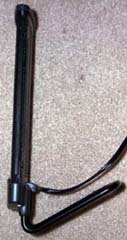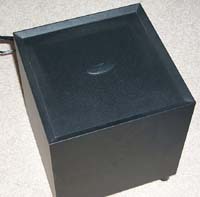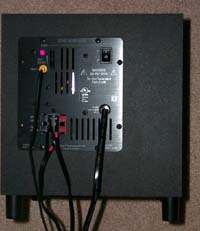
Original Link: https://www.anandtech.com/show/430
Monsoon MM-700 Flat Panel Speakers
by Mike Andrawes on December 26, 1999 8:39 PM EST- Posted in
- Smartphones
- Mobile
|
Quick Look |
||
|
Monsoon
MM-700 |
The Good | |
|
|
+
Smooth frequency response |
|
| The Bad | ||
| -
Very directional sound - No satellite angle adjustment |
||
There's no doubt about it, the flat panel craze is on. The gradual move to flat panel LCD monitors has begun. By design, CRT monitors are bulky, power hungry devices. LCD displays promise to kill the CRT tube and provide displays that take up almost no room on a desk and draw much less power.
This move was easily predictable - afterall, it only makes sense. But who would have thought a few years ago that there would be a push towards flat panel speakers, too?
Actually, the technology has been around for quite a while - since the 70's in fact. However, that technology was far too expensive for the vast majority of the public and standard cone speakers dominated the market.
But times are changing. A few months ago, AnandTech took a look at two of the first flat panel multimedia speaker systems - the Benwin BW2000 system and the highly praised Monsoon MM-1000 system. We found the Benwin BW2000's to be interesting, but an overall weak and underpowered system. The Monsoon MM-1000, on the other hand, was much more powerful and featured excellent sound. Unfortunately, the MM-1000's were held back by some odd quirks in the systems design and a relatively steep price. Monsoon is back with their more affordable MM-700 set. The specs are similar to the old MM-1000's, so let's dig deep and find out what has changed...
Specifications (courtesy of Monsoon):
- Satellites: 4 X 8 inch dipole radiating planar magnetic
- Satellite enclosure: None
- Amplifier power: 44 Watts
- Total system power: 2 x 11 Watts, Satellites, 22 Watts, Subwoofer
- Crossover: Active, 3rd order at 250Hz Woofer drive unit: 5.25-inch cone, Xmax = +4mm (per DUMAX measurement)
- Woofer cabinet: 6.9 liters, tuned to 65 Hz; 10"H x 9"W x 9"D
- Controls on woofer: Bass volume, power
- Controls on puck: Volume
and mute
- System frequency response: 50 Hz to 20 kHz in workstation environment
- System time response: Less than .25 ms dispersion to -20 dB Maximum SPL at .5 meters: 99dB RMS using EIA 426B noise
Technology Brief
The technology behind the Monsoon speakers isn't anything new, but Monsoon/Sonigistix just claim that they are the first to use mass production techniques to bring it to market at an affordable price. The concept is actually very different from the path chosen by Benwin/NXT. This time, it's called Planar Focus and sound is generated as a thin mylar membrane vibrates in a special enclosure. Instead of aiming for an enlarged sweet spot and room filling sound from small speakers, like the Benwin/NXT setup, Planar Focus is designed to produce very directional sound.
The reasoning behind this step is that such directional sound will minimize reflections from the desktop, monitor, and anything else providing optimal sound for 3D sound from two speakers, such as Aureal's A3D. At the same time, sound will, theoretically, be extremely crisp and powerful - crisp due to the lack of reflections and powerful due to increased efficiency since a heavy cone need not be moved. Instead of a large sweet spot, the goal is for a very fixed one that should be fine for a single computer user with the speakers correctly positioned. Trying to use Planar Focus to produce music for a room full of people just won't work very well.
One of the biggest problems in generating 3D positional audio from two speakers is cross talk from the speakers where your left ear hears what's coming from the right speaker and vice versa. Clearly such a directional speaker will help prevent this to a degree, and of course 3D sound algorithms attempt to do the same.
Functionality
This category is the one in which the MM-700's really hold an advantage over the older MM-1000's. The issues we had with the remote volume control puck on that older model are no longer present. That means the mute button actually mutes the system completely now and unexpected volume changes are not present either. The puck is now the only volume control available in the system. In fact, the puck is integral to the systems function as you connect the puck between your computer and the sub.
Monsoon has also added a power switch to the back of the sub so it can be shut off completely if desired. Then they said goodbye to the external AC adapter by integrating it into the subwoofer enclosure. Also gone are the bass boost button and bass level controls, replaced by a simple woofer volume control on the back of the sub.
The satellites are still hooked up to push button terminals on the sub via standard speaker wire that is permanently attached to the satellites. The removable satellite stands offer some interesting mounting options, including the aforementioned kit from Monsoon for connection with an NEC flat panel display.
Sound Quality
The specs of the MM-700's are actually quite similar to those of the more expensive MM-1000's. Both feature 4 x 8 inch dipole radiating planar magnetic satellites in conjunction with a 5.25" woofer. The similarities stop there, however. The MM-700's have a bit less power at 44W, which is down from 50W total for the MM-1000's. The loss comes in the form of 1.5W per satellite, down to 11W, and 3W on the sub, down to 22W.
Further, the satellites are not actually identical as the MM-700's feature a newer design that allows a smaller enclosure for the satellites. The satellite stands are also detachable now, allowing for some interesting mounting options, including a package directly from Monsoon that allows the satellites to mount directly to certain NEC flat panel monitors.
The sub woofer also features a similar woofer, but this time in a smaller enclosure, 6.9 liters instead of 8.2, which leads to a higher peak frequency - 65 Hz instead of 50 Hz. Furthermore, the woofer is now a downfiring, bottom ported design. Unlike some other manufacturers with downfiring woofers, Monsoon was wise enough to include a metal grill to protect that woofer.
All these changes lead to a maximum SPL rating of 99dB versus the 102 dB of the MM-1000's, making this set a bit quieter at peak volume, but they are nevertheless capable of fairly high volumes. Those high volumes are obtained with minimal distortion until the volume knob was turned past 3/4 of the way up. At that point some distortion set in, primarily in the sub.
The overall quality of the sound was excellent, with crisp highs and full mid range thanks to the planar focus satellites. As noted previously, planar focus technology is very directional. Half the sound seems to disappear if you turn the satellites 90 degrees. Just make sure the satellites are pointed at your ears - a feat that can sometimes be tricky with the non-adjustable stands.
However, this directionality helps considerably with A3D positional audio. In fact, directional effects in A3D have never sounded better from a single pair of speakers (excluding the MM-1000's). The directionality of the speakers minimize reflections and eliminate crosstalk, enhancing the positional effects of A3D.
The sub does feature a relatively high 250 Hz crossover, allowing some of the midrange to bleed through to the sub. This does muddy up the midrange slightly, but, fortunately, the effect is minimal thanks to the steep slope of the third order crossover employed. That crossover is actually very well implemented and provides a very smooth transition from satellite to sub.
Once again, thanks to the directionality of the technology and the medium sized sub, don't expect to hold a party with this speaker set. They are, however, more than sufficient for a single user at his/her PC.
|
Quick Look |
||
|
Monsoon
MM-700 |
The Good | |
|
|
+
Smooth frequency response |
|
| The Bad | ||
| -
Directional sound - No satellite angle adjustment |
||
Conclusion
Think of the Monsoon MM-700's as a slightly less powerful, but otherwise much improved version of the MM-1000's. Sound quality is almost the same, but the price is much lower. In fact at the time of this review, the MM-700's were going for $109 after a $40 rebate directly from Monsoon. Compare that to the MM-1000's at $199, and choosing the MM-700's over the MM-1000's is a no brainer. To make things even sweeter, its fairly easy to find the MM-700's for about $110 before the rebate with a bit of searching on the internet.
Now, the question remains whether the Monsoon MM-700 with its planar focus technology is a good buy at $109. For that price, you get extremely crisp mids and highs thanks to the planar focus technology. While the sub is less inspiring that the satellites, it is more than sufficient for a single PC user. Remember that this is the intended market of the MM-700's, due to the extreme directionality of the speakers, which is perfect for a single user sitting in front of them, but not so good for filling a room with sound.
With all that in mind, it's tough to pass up the MM-700's if you fit the intended audience. The sound quality is excellent and the directionality enhances A3D surround sound from just two speakers. And don't forget the "wow factor" that comes from owning a set of flat panel anything. ;)













